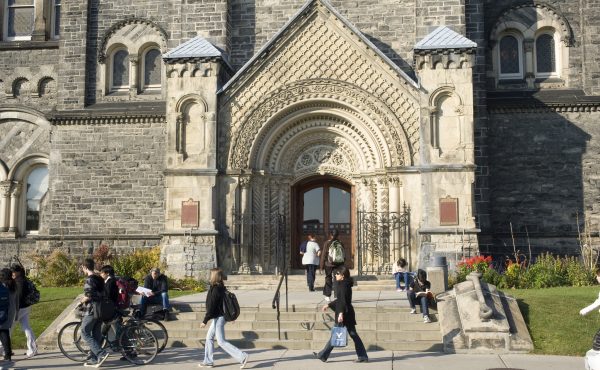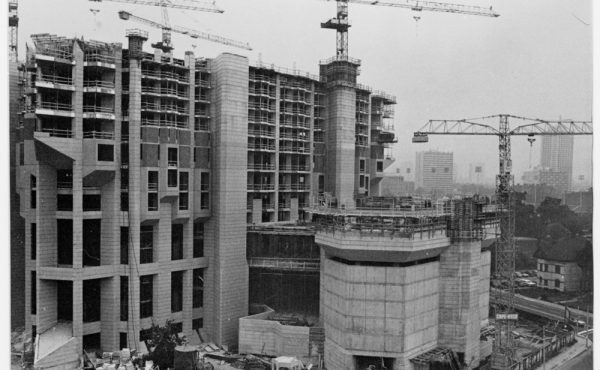![]()
Ryerson University announced Wednesday that architectural firms Zeidler Partnership Group of Toronto and Snohetta of Oslo, Norway have been hired to design the school’s new Student Learning Centre at the corner of Yonge and Gould. The hiring represents a significant step forward in the university’s marquee plans to redevelop the Sam the Record Man site.
While a complete plan for the site is still at least a year away, the architects were on hand to talk about their previous experiences and their initial ideas around the project. Their collective resumes are very impressive. Snohetta’s CV includes the new Library of Alexandria and Oslo’s National Opera. The firm is currently working on the September 11th memorial museum in lower Manhattan, the King Abdulaziz Centre for Knowledge and Culture in Mecca and new university libraries in Ohio and North Carolina. Toronto’s Zeidler architects have been involved in international projects in Tel-Aviv, London’s Canary Wharf and Seoul. Right now, they’re working on the revitalization of the Union Station rail shed.
It is clear from this selection that Ryerson views the site as an opportunity to do something special both for the school and for the city as a whole. Lead architects Tarek El-Khatib and Craig Dykers made clear that they too understand the potential for the site and the intricate role it will play in linking the campus with the city, while further enhancing the vibrancy of Yonge Street. To this end, the architects acknowledged that the building will have retail along Yonge Street and will attempt to keep up with the round-the-clock liveliness of the area. “The context is extremely important…there’s a great movement to create this public environment around Dundas and the whole force of it is creeping up the street,” said El Khatib. “There has been also some great efforts at changing the character of Gould Street so that is going to become a very important players in how the ground floor works.”
The architects created a video of a visit to the site and their consultation with students on what the new centre should be:
[youtube]http://www.youtube.com/watch?v=VYDH6MFuwqI[/youtube]
Ryerson president Sheldon Levy was obviously excited about the project and emphasized his wish that the library be adaptive to the future. “It will be successful because it will filled with energy of thousands of Ryerson students,” he said. “Yonge and Gould will become a dynamic corner…it will be what city building is at its best.” While the university clearly wants the building to be its ambassador to the city’s main street, it also stressed that it considers the project essential to its own future. Officials said that the focus of the new building will be on creating places for social interaction amongst students.
Many details will be worked out in the coming months through collaborations between the architects, students, and Ryerson librarians. It remains unknown how the building will incorporate retail and what type of retail it will include. It is possible that the building will have a direct connection with Dundas subway station, and it’s also possible that Gould Street will be closed to traffic by the time the building is complete. Acknowledging that the first floor of the building will have to be public, the architects say they will look for a way to acknowledge the library function of the building to visitors without them disturbing the students and those studying. How the building will connect with the existing library structure presents a further challenge to architects; Ryerson will keep its current library building functioning. When asked if the building would incorporate some homage to the old Sam the Record Man that once defined the corner, Levy said that was definitely a possibility and acknowledged the continued existence of the old neon signs.
The very concept of this building is based around a new look at the traditional concept of a library — beyond not only the traditional depository of books but also past the more recent concept of a confluence of electronic media. Ryerson is using the terms “Library” and “Student Learning Centre” interchangeably in this context. Without compromising on the traditional needs of print material and information accessibility, the student centre reflects a highly contemporary idea of the social gathering places that libraries need to be.
photo by Sam Javanrouh




20 comments
When the students are walking around the construction site, will they be checking to see if the architects and site supervisors look like them?
I think it’s really great what Ryerson is doing downtown. Some roll their eyes at the ‘Best Buy’ building, but I think it’s good use of that space.
Also, a similar project is being considered in London Ontario. Fanshawe College is looking to take over some heritage buildings in the downtown, which is currently in very bad shape – London is really a suburban ‘community.’
http://www.lfpress.com/news/london/2010/02/09/12798686.html
I really hope that the building does *not* incorporate any Sam the Record man pieces—time to move on.
The architect news is encouraging — seems like Ryerson intends to make the most of this space.
Given that, I have to agree with Brian. Saving the Sam’s sign seemed like a good idea way back when, but it’s hard to see it making sense as part of a landmark university building. Perhaps it could be reassembled down the street on one of the buildings overlooking Dundas Square, where it’d fit perfectly.
The (over)use of the word “acknowledge” in this piece makes it sound like the author thinks Ryerson has something to hide. Is that so?
Scratch that, it was just the collision of a too-skimmy first read and the need for synonyms (concede? accept? agree?).
“How the building will connect with the existing library structure presents a further challenge to architects; Ryerson will keep its current library building functioning.”
Seriously, it’s not worth it. The current library/podium/whatever building is an absolute disaster. Brutal on the outside, with an inside designed to be as painful as possible to manoeuver. Demolish it.
Perhaps the interior of the “brutal” library could be revamped to simultaneously make it easier to use and easier to connect to this new building? Maybe this is already part of the plans. I think we should be way past the point of demolishing anything by now…Toronto has demolished so much in the past; instead, we should be looking at innovative ways to adapt existing buildings to changing needs.
@John Duncan, you hit the nail on the head there. The library building is a great example of brutalist architecture 😉
Wow, Snohetta in Toronto. To paraphrase Paris Hilton, that’s hot. Go RU.
@Magda
I dislike brutalist architecture, primarily for its interactions with the public realm. Often ugly (or poor-wearing) materials, visual & physical scales too large for pedestrians, and exterior design that betrays a poor understanding of the tolerances and comfort levels of the human body. Sometimes it works on the inside at least.
But despite my opinions of them, I wouldn’t say that we should demolish Robarts, the Harbour Castle (except its conference hall), the HBC, etc.
The current Ryerson library building is an unmitigated failure both inside and out. To fix the problems with it would require a complete gutting, as well as heavy reconfiguration of the outside areas near the entrance. At that point, you’re pretty close to demolition.
Its ground floor is actually half a storey below ground, meaning that the too-narrow main entrance leads directly onto a set of stairs. There is a ramp for stair-free access, but it narrows to an awkwardly small width. Directly inside is the main staircase for getting up and down (library’s on the third floor), which is far too narrow and designed to force students to walk into each other. This area is often swamped as it’s right next to one of the school’s larger lecture halls. Above the third floor, the stairs turn into one-person wide escalators that generally aren’t working. Of course there is also the smallest and slowest elevator on campus as an option.
The building is simply dysfunctional on a student circulation level. The air circulation and climate control are also exceedingly poor. And I hope you don’t like natural light as the architect didn’t believe exterior windows were all that necessary.
The outside of the building has those public terraces that are full of people in renderings, but in reality never see more than a handful of smokers. These ones are exposed to the elements (but not much sunlight), have very few points of connection with the ground or the building, and no furniture to sit on.
Seriously, pay it a visit on a weekday at the top of an hour. Better yet, borrow someone’s wheelchair and give it a go. Preserving our heritage is important, but some buildings are simply bad and don’t deserve saving.
John, I’d disagree with your first para on what’s wrong with brutalism (in general). I think that’s why it works. Brutalism, good brutalism, makes the inside and outside come together and uses lots of materials that feel a lot like a walk on a mountain path in the Rockies (concrete as exposed rock, lots of smooth, long pieces of wood). I love Robarts and think it’s perfect as a library. I’ve not been in the RU one though – but will go check, in an effort to see an example of bad brutalism. If it is, I won’t defend it. There are bad versions of all architecture styles.
John,
Thanks for sharing. I’ve not been inside that building, although I’ve passed by it in the past, and did get the impression that it was quite fortress-like. The lack of natural light is a problem but that is always a challenge with buildings of that scale, I think. The way the building connects with the public realm at grade is also obviously poor. But demolishing a problem building and then building anew isn’t a guarantee that all the problems will be addressed. Maybe it is, as you say, beyond the point of saving; but there are some pretty brutal buildings in Rome that have stood for thousands of years and are being used with success today. I would hope there is always hope, but can’t insist on it since I haven’t witnessed it first-hand.
The thing with libraries – natural light & books don’t always get along.
That’s true…I think for a facility like this one, it would be important to keep books out of direct sunlight, but provide light and views for areas where people work, like offices or study areas.
Uh, isn’t ‘student learning centre’ the definition of, y’know, a school?
Just sayin’.
John and Shawn make some interesting points in discussing whether or not we should tear down dysfunctional brutalist buildings or conserve them in the name of architectural preservation. Aside from the impossibility of ever making buildings like Robarts or the Ryerson library work from a strictly utilitarian point of view, perhaps we could best honour the spirit of the time in which they were built by razing them to the ground without a second thought. After all, that’s what architects and developers did with the existing buildings when they put up these monstrosities in the first place.
pman is funny, but as somebody who loves Modernism, I’m always torn that many of the them went up after lovely Victorian and etc buildings were torn down quickly and without thought. There is room in Toronto for both.
Apart from not liking brutalism, how does Robarts not work? I’ve done some good reading in there.
>Apart from not liking brutalism, how does Robarts not work? I’ve done some good reading in there.<
four floors of single-file escalators would be one thing. still, i’m glad you are here to be a voice of reason on this–people’s expectations of what a building should do often exceed what that building can physically accommodate, especially thirty years after the fact. when my mother was a student, they called robarts “fort book”–i’s not like nobody was aware when it was built that it was a hulking beast; maybe “fortress-like” just wasn’t the pejorative term it is now.